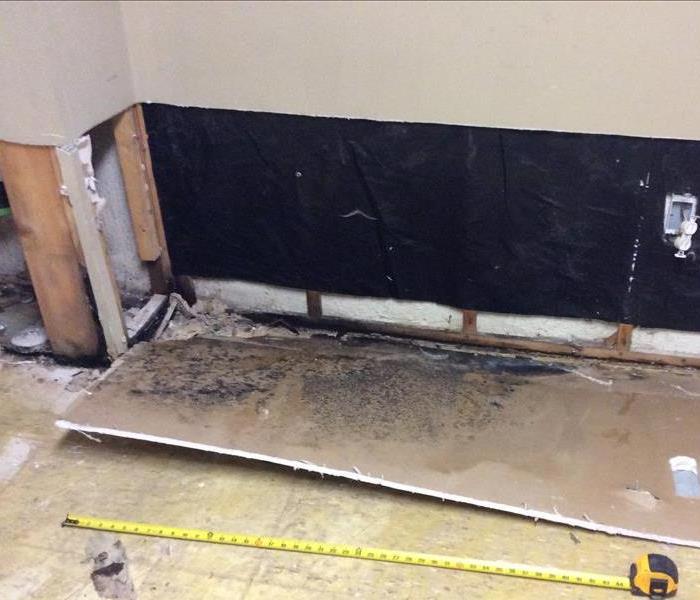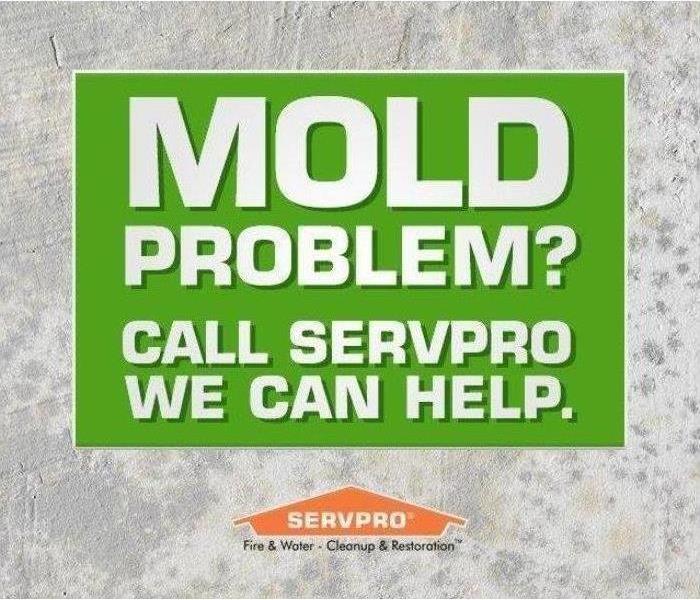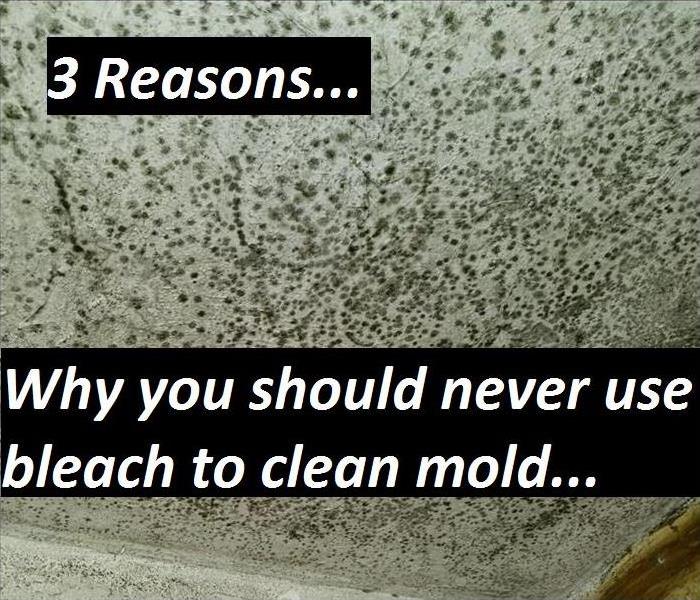Archived Mold Remediation Blog Posts
Black Mold
2/2/2018 (Permalink)
Black mold is one of the worst fears you might have as a homeowner. Toxic black mold (Stachybotrys chartarum) grows in common household features such as carpet, drywall, insulation, and sub-flooring. It grows when these household materials have been in contact with moisture. As it grows, it releases spores into the air.
Where to Test for Black Mold
Testing for mold is essential, and you should have a dwelling inspected for black mold before you buy it or sign a lease. If you suspect there may be black mold in your home, or you have never had your home tested, contact SERVPRO of Livonia for professional mold remediation services in the Metro-Detroit area. While many aspects of home-ownership can be handled in a D.I.Y. fashion, black mold is not something to be messed around with.
Carpet
Black mold loves to live on the carpet. Dust collects in carpet fibers and those same fibers trap the humidity and dampness that enables mold to grow. Carpets in below-ground levels are especially susceptible to mold as there is more humidity there.
Carpet mold is often not visible from the surface, except in severe cases, which makes testing for it necessary even if you don't see any evidence.
Air Conditioning and Heating Vents
Air conditioning and heating vents actually create ideal conditions for black mold to grow. Dual-purpose vents that both heat and cool your house raise that risk as they are in constant use.
When you have mold in your air vents, those spores are being circulated throughout your home. The sooner you can perform mold remediation procedures, the better. SERVPRO of Livonia has a 24-hour mold emergency service hotline to quickly begin the process of cleaning your air vents.
Drywall
Mold is unfortunately common in drywall, as it traps humidity. This is especially common as the seasons change from winter into spring. Because of the nature of it, mold in drywall is rarely visible except in severe cases. For this reason, it's imperative to have a potential home be tested for mold in the walls before you sign a lease or put down a deposit.
What to do about a mold problem...
1/16/2018 (Permalink)
What’s the Difference?
Since microscopic mold spores exist naturally almost everywhere, indoors and outdoors, removing all mold from a home or business is impossible. Some restoration businesses advertise “mold removal” and even guarantee to remove all mold. This is a fallacy.
A qualified restoration company understands the science behind mold and mold growth. SERVPRO Franchise Professionals have the training and expertise to remediate the mold in your home or business. Mold remediation focuses on getting mold levels back to normal, natural levels.
Every mold damage scenario is different and requires a unique solution, but the general mold remediation process stays the same.
Step 1: Emergency Contact
Step 2: Inspection and Mold Damage Assessment
Step 3: Mold Containment
Step 4: Air Filtration
Step 5: Removing Mold and Mold-Infested Materials
Step 6: Cleaning Contents and Belongings
Step 7: Restoration
Understanding Mold
When water intrudes into your property, mold growth can start in as little as 48 hours. Consider the following mold facts: Mold is present almost everywhere, indoors and outdoors.
- Mold spores are microscopic, float along in the air, and may enter your home through windows, doors, or AC/heating systems or even hitch a ride indoors on your clothing or a pet.
- Mold spores thrive on moisture. Mold spores can quickly grow into colonies when exposed to water. These colonies may produce allergens and irritants and have the potential to cause other health effects.
- Before mold remediation can begin, any sources of water or moisture must be addressed. Otherwise, the mold may return.
- Mold often produces a strong, musty odor, and that odor can lead you to possible mold problem areas.
- Even higher-than-normal indoor humidity can support mold growth. Keep indoor humidity below 45 percent.
What to Do:
- Stay out of affected areas.
- Turn off the HVAC system and fans.
- Contact a SERVPRO Franchise Professional for mold remediation services.
What NOT to Do:
- Don’t touch or disturb the mold.
- Don’t blow air across any surfaces with visible or suspected mold growth.
- Don’t attempt to dry the area yourself.
- Don’t spray bleach or other disinfectants on the mold
Finding Hidden Mold
1/11/2018 (Permalink)
Modern building materials including wood, drywall, grout, and wallpaper are all appealing food sources for mold. All they need is a little moisture, and mold spores can take hold and create an entire colony hidden behind the walls, beneath the floor, or above the ceiling in your home. With homes built the way they are today—tightly, with energy efficiency in mind—water from a leaky roof or vapor from the dishwasher can easily get trapped inside. This creates a recipe for disaster, one that could cause health effects.
Finding Hidden Mold in Your Home
Hidden mold can also destroy home value by damaging its structural integrity. It’s something you want to get rid of as quickly as possible.
If you think you might have hidden mold growing in your home, use these tips to find it:
Hire a professional: The easiest and best way to find out if your home has hidden mold is the hire a professional mold remediation company like SERVPRO. We know how to quickly and successfully find and eliminate mold in your home while causing the least amount of disruption to your daily life possible. Some of the other methods listed below can be challenging to perform without the help of an experienced pro.
Check the roof for leaks:Visit the attic and pull up insulation to check for hidden mold there. Roof leaks can also result in ceiling water stains and sagging drywall, other indicators for hidden mold growth.
Check for leaky pipes: This obvious sign of water intrusion could be causing mold growth on the other side of the wall. Examine all fixtures for leaks, including the bathroom and kitchen sinks, toilet, refrigerator, washing machine, and all other water and sewer supply lines.
Test the humidity with a hygrometer: If any rooms have relative humidity higher than 60 percent, hidden mold is likely in that area.
Examine the inside of cabinets: Remove drawers and look thoroughly at all wood surfaces in kitchen and bathroom cabinetry. You may even need to remove the cabinets in their entirety to examine the wall and floor beneath the installation. This, however, will most likely require the help of a professional.
Have the ductwork inspected: Mold can grow inside the ductwork and spread spores all over your home. An inspection from SERVPRO may reveal the problem.
Have the ceilings, walls, and floors tested for dry rot: Elevated internal moisture and dry rot is an indication that hidden mold is growing there.
Remove sections of wallpaper: Cut one-inch square pieces from the wallpaper every several feet. Examine the backside of the samples for mold growth.
Cut holes in the drywall: This can be seen as a drastic move by many homeowners, but if you have hidden mold behind the walls in your home, it’s important that you find it as soon as possible. Use a flashlight to examine the wall or ceiling cavity. Smell the air and try to pick up on any musty odors that indicate mold growth.
SERVPRO has the expertise and knowledge required to remove mold from the basement, crawlspace, attic, or anywhere else it has started growing in your home or business. Call 734-744-8104 today if you suspect mold anywhere in your home or business.
Why not to use bleach to clean mold...
1/8/2018 (Permalink)
Chlorine Bleach is often regarded as the answer for stopping mold growth and removing the mold. However, this is a myth. Bleach does not exonerate mold. Here are three reasons why bleach is not the answer to mold, and should never be used to clean a mold contaminated area.
1. Bleach Loses Effectiveness over Time
Chlorine bleach can dissipate rapidly, causing the bleach to be less effective. Over time this occurs because chlorine can evaporate and even faster in areas that are above room temperature. When the chlorine disappears, the bleach bottle turns into a bottle of salt water.
2. Bleach can actually contribute to mold growth
Chlorine bleach was made to clean surfaces, therefore can only kill surface bacteria and mold. This is due to bleach’s ion structure, which prevents the chlorine from penetrating porous material such as wood and drywall. When mold grows in porous areas, the enzyme’s roots grow deep within the material, rendering the bleach ineffective of exterminating the mold. The bleach can only remove the green stain from the mold, allowing surface to appear clean. But underneath the surface, the water component of the bleach penetrates and helps the internal roots to continue to grow, causing mold to reappear.
3. Bleach is Toxic
Bleach emits harmful fumes that pollute the air we breathe and can cause health effects to humans and even pets. Also research shows that household bleach is one of the leading causes of accidental poisonings in the United States.
Mold Damage in Livonia, MI
11/15/2016 (Permalink)
 This mold grew behind wall paneling.
This mold grew behind wall paneling.
Mold can cause many health concerns. The worst part is the sneezing, headaches, fatigue, coughs, etc. can all start before the mold is found. Mold grows when there is moisture, warmth and oxygen. Water damage can quickly lead to mold, therefore mold can be hiding in your walls, ventilation systems, and many other areas not easily visible.
Certain molds can be highly dangerous to remove on your own. The reason it's important to hire a mold remediation company to handle all your mold needs. The proper technicians will be able to not only remove the visible molds, but also the spores from which it grows. Certain molds are highly toxic and dangerous to remove without the proper equipment.
SERVPRO mold remediation technicians will be fully equipped with Haz-Mat suits, full respirators and the cleaning materials necessary to handle the full spectrum of mold infestations. Removing mold is not an easy task. It's just one more reason to call SERVPRO of Livonia.

 24/7 Emergency Service
24/7 Emergency Service

